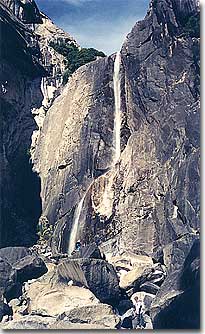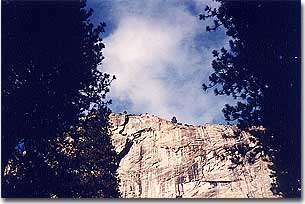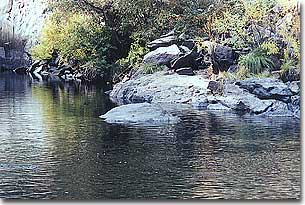Trout Take Over Yosemite In Fall
Trout Take Over Yosemite In Fall
By Dan Fallon
After summer's tourist depart, anglers enter for the excellent fishing found in California's premier national park
 From September to December weather permitting, trout fishermen often find themselves alone on the many lakes and streams that contain trout. The 21/2 million visitors who roam Yosemite National Park each season have left, while hungry native rainbows prowl the shallow streams in search of perfectly presented flies and salmon eggs. The pursuit of trout is the best excuse to grab a front-row seat and watch Mother Nature gently cover her Yosemite in quiet winter robes. The rainbow is the only true native trout in the park. Its particular twist of DNA can be traced to the Merced and the Tuolumne rivers. The Pleistocene Glaciers destroyed the ancient trout habitat, and fish no longer could climb back upstream and spawn.
From September to December weather permitting, trout fishermen often find themselves alone on the many lakes and streams that contain trout. The 21/2 million visitors who roam Yosemite National Park each season have left, while hungry native rainbows prowl the shallow streams in search of perfectly presented flies and salmon eggs. The pursuit of trout is the best excuse to grab a front-row seat and watch Mother Nature gently cover her Yosemite in quiet winter robes. The rainbow is the only true native trout in the park. Its particular twist of DNA can be traced to the Merced and the Tuolumne rivers. The Pleistocene Glaciers destroyed the ancient trout habitat, and fish no longer could climb back upstream and spawn. In the late 1800s pioneers carrying buckets and tin cans attempted to plant rainbows taken from the rivers into barren lakes like Vernon, Kibbie and Laurel. In 1892, soon after Yosemite was designated a national park, fish stocking was begun. In 1897 the first brown trout were introduced into lakes and streams. These browns are excellent fighters, and are thriving today in the lower Merced River, where warmer waters are conducive to rapid growth and reproduction. The rare golden trout was also planted in various lakes, but today few are to be found. Several other fish such as Dolly Varden, American graylings and cutthroats were stocked over the years, but most of these fish have, disappeared. A few cutthroats can still be found in desolate high, country lakes, however. Trout fisherman of either fly or spinning persuasion can expect to fish primarily in the lakes in fall, when the two main rivers, the Merced and the Tuolumne, are usually running at low ebb. The great news is by late September few of the 21/2 million who visit the park each year can be found snapping a fly rod or casting a lure. In fact, less than 10 percent of all park visitors are fishermen, for the trout fishery is not the main attraction, despite the number of beautiful lakes to be found in Yosemite. Within the 761,757,000 acres of the park, 338 lakes are thought to be capable of sustaining trout populations. Of these, 127 lakes contain enough fish for self-propagation. Those anglers who wish to fish within easy reach of the main roads will find Tenaya Lake (named after the famous Miwok Indian chief) a good place to start. Tenaya is located off Tioga Road and, at 150 acres, is one of the three largest lakes in the park. The trout available are brookies and rainbows - as is the case with most all the lakes. During the tourist-thick summer these fish are hard to catch, but by late fall in early morning or late afternoon savvy fly fishermen, using eight or nine-foot medium weight fly rods, can expect good action. The most popular fall flies are black gnats, red and black ants, well-made and well-presented hoppers, mosquitos, Royal Coachman, Grey or Brown Hackle with yellow or peacock body, in sizes 10,12 or 16. Those who prefer spinning outfits should bring an assortment of lightweight lures such as Panther Martin or Mepps in silver and black.
 The tried and true red salmon egg on a size 12 hook, with six feet of light leader, will always catch fish in the park. Yosemite trout are for the most part wild, but of course they are just trout, which is not to say trout as a species are gullible. But rangers do hear tales of 7-year-old youngsters with $10 plastic outfits catching limits.
The tried and true red salmon egg on a size 12 hook, with six feet of light leader, will always catch fish in the park. Yosemite trout are for the most part wild, but of course they are just trout, which is not to say trout as a species are gullible. But rangers do hear tales of 7-year-old youngsters with $10 plastic outfits catching limits. Tenaya is an ideal lake to use the popular bubble and fly rig in conjunction with light spinning gear. The sliding bubble is kept above a swivel that separates the leader and fly from the main line. The bubble acts as a weight and keeps the fly afloat. This system allows the fly to be cast long distances; of course, the fly still has to be presented as naturally as possible. This is a valuable system to learn if you are not adept at fly fishing, but would like to enjoy the thrill of catching wild trout on flies. Hetch Hetchy, the largest body of water in the park at 2000 acres, is also accessible by auto. Its trout are also a bit wily in summer, but in the fall the lake comes alive with the expanding rings of trout exploding the calm surface in pursuit of insects. This big lake has many areas with tree overhangs and boulders which cast large shadows, a favorite holding zone for veteran older trout. The careful use of hoppers and other terrestrials can be very effective, if they are presented naturally in these dark-water spots. In 1972 a program of restoring the park's fishery to a more "natural condition" was undertaken, and lakes and streams were allowed to become self-propagating. In the years that followed only a select few lake have been stocked. As a result of this forward thinking, the eastern brookie, for instance, has returned to its ancient perfection. The distinct wavy, worm-like patterns on the backs of these wild fish are not found on hatchery-raised fingerlings. It seems only fish allowed to thrive on natural foods and left to self-propagate display these vivid vermiculated markings. Stream fishermen, drought conditions permitting can find good action on the Merced headwaters just past Arch Rock entrance off Highway 140. Within one mile of this entrance, fly and spinner fishermen can spend rewarding late afternoons watching large numbers of rainbows and brookies swim and rise in transparent waters as falling leaves drift lazily by. Dead-drifting mosquitos or nymphs on six to nine-foot light leaders can be deadly if the bite is on. A good tip in regard to catching fall trout in times of windy, shadow-splattered water is to rig a strike indicator. One can use any of the many available, a piece of bright cork or yarn placed at water surface level will help you to spot strikes in changing conditions. Most of the trout caught in Yosemite are pan-size, with 10 or l2-inch fish most common, but these wild trout display none of the lethargy found in their hatchery-raised cousins.
 Lower Cathedral Lake is only 1.5 miles from Tioga Road. This lake is 11 acres in size, and fishing is generally good if anglers employ a low profile and try to stay well back from this little lake's shore. The trout roam the shallows in early morning in search of tasty morsels, and both fly and spinner outfits work well. If one is lucky enough to witness a good insect hatch, the amount of fish rising will astonish even seasoned fishermen. The relatively low fishing pressure on this lake, as is the situation on most park lakes, translates into large trout populations.
Lower Cathedral Lake is only 1.5 miles from Tioga Road. This lake is 11 acres in size, and fishing is generally good if anglers employ a low profile and try to stay well back from this little lake's shore. The trout roam the shallows in early morning in search of tasty morsels, and both fly and spinner outfits work well. If one is lucky enough to witness a good insect hatch, the amount of fish rising will astonish even seasoned fishermen. The relatively low fishing pressure on this lake, as is the situation on most park lakes, translates into large trout populations. Trekking off the beaten path, you will find Buena Vista Lake 12 miles from Glacier Point Road. This makes for a pleasant two-day trip. The fishing can be excellent - as is usually the case the farther one is from main roads. In the last hour before sunset trout are usually active and hitting lures and flies. Buena Vista is a fine spot to camp, too. One of the best-kept secrets in the park is Washburn Lake, 6 miles from Yosemite Valley and 39 acres in size. Both rainbow and brook trout abound in this hidden pocket of water. The scenery is majestic, and when the bite is happening, the fishing is outstanding. The smaller size 16 flies which are more like the tiny insects found at higher elevations are useful here. The natural food chain, becomes much smaller the higher one ventures. Rodgers Lake is 19 miles from Harden Lake, and is 44 acres in size. Being situated at 9000 feet altitude, this lake is lightly fished and fishing is good most of the time. In fall this lake is often deserted, and the fish are easy to catch at feeding time. The Catch and Release philosophy is made for Rodgers Lake, where one may find the fishing so good that every cast can bring a hit or fish. In this kind of trout utopia it is important to gently play and release trout unharmed, so this fragile resource is left intact for future fishermen. Anglers not familiar with the demands of a 20-mile backcountry hike are advised that the trail to the next lake is not a walk in the park. For experienced high country fishermen, though, Benson Lake (named for one of the original protectors of the park, Col. H.C. Benson of the fourth US Cavalry) is located in the heart of the north end of Yosemite at the end of a rugged, 20-mile hike. It's two and a half days by either horse or foot. Benson, at 144 acres, is one of the three largest lakes. The fishing is superb, and the lake sees few visitors at any time of year. The scenery is impressive at the 8000 to 9000-foot Hudsonian life zone. The fragrance of white bark pine and mountain hemlock fill the crisp air, bluebirds and black-backed woodpeckers provide the music. Belding's ground squirrels scurry about pre-winter appointments, while herds of mule deer sample tasty grasses. John Muir often spoke of how the park carried one far beyond "human cares and human civilization." Those lucky fly and spinner enthusiasts who wonder and ponder Yosemite in the fall are indeed lifted beyond the slightest pre-winter blues.
|
